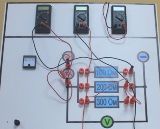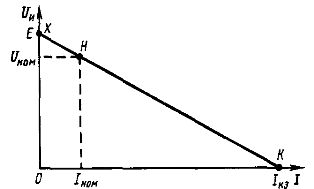Modes of operation of the electrical circuit
 For an electric circuit, the most characteristic modes are load, no-load and short-circuit modes.
For an electric circuit, the most characteristic modes are load, no-load and short-circuit modes.
Charging mode… Consider the operation of an electric circuit when it is connected to a source of any receiver of resistance R (resistor, electric lamp, etc.).
Based Ohm's Law NS. etc. c. the source is equal to the sum of the voltages IR of the external section of the circuit and IR0 of internal resistance of the source:

Given that the voltage Ui and at the source terminals is equal to the voltage drop IR in the external circuit, we get:

This formula shows that NS. etc. c. the source is greater than the voltage across its terminals by the value of the voltage drop inside the source... The voltage drop IR0 inside the source depends on the current in the circuit I (load current), which is determined by the resistance R of the receiver. The higher the load current, the lower the source terminal voltage:

The voltage drop across the source also depends on the internal resistance R0.The dependence of the voltage Ui on the current I is depicted by a straight line (Fig. 1). This dependence is called the external characteristic of the source.
Example 1. Determine the voltage across the generator terminals at a load current of 1200 A if e. etc. s. is 640 V and the internal resistance is 0.1 Ohm.
Answer. Voltage drop across the internal resistance of the generator

Generator terminal voltage

Of all the possible load modes, the nominal one is the most important. Nominal is the mode of operation established by the manufacturer for this electrical device in accordance with the technical requirements for it. It is characterized by nominal voltage, current (point H in Fig. 1) and power. These values are usually indicated in the passport of this device.
The quality of electrical insulation of electrical installations depends on the rated voltage and the rated current — their heating temperature, which determines the cross-sectional area of the wires, the heat resistance of the applied insulation and the cooling rate of the installation. If the rated current is exceeded for a long time, it may damage the installation.
Rice. 1. External characteristics of the source
Standby mode… In this mode, the electrical circuit connected to the source is open, i.e. there is no circuit in the current. In this case, the internal voltage drop IR0 will be zero

Therefore, in idle mode, the voltage at the terminals of the source of electrical energy is equal to its e. etc. (point X in Fig. 1). This circumstance can be used to measure e. etc. v. sources of electricity.
Short circuit mode. Short circuit (short circuit) such a mode of operation of the source is called when its terminals are closed by a wire whose resistance can be considered equal to zero. Practically c. H. occurs when the wires connecting the source to the receiver are connected together, since these wires usually have negligible resistance and can be taken as zero.
A short circuit can occur as a result of improper actions by personnel servicing electrical installations or if the insulation of the wires is damaged. In the latter case, these wires can be connected through the ground, which has a very low resistance, or through the surrounding metal parts (electrical machine and apparatus housings, elements of the locomotive body, etc.).
Short circuit current

Due to the fact that the internal resistance of the source R0 is usually very small, the current flowing through it increases to very large values. The voltage at the short-circuit point becomes zero (point K in Fig. 1), that is, electrical energy will not flow to the section of the electrical circuit located behind the short-circuit location.
Example 2. Determine the short-circuit current of the generator if its e. etc. with equal to 640 V and an internal resistance of 0.1 ohm.
Answer.
According to the formula

A short circuit is an emergency mode, since the resulting large current can render the source unusable, as well as the devices, devices and wires included in the circuit. Only for some special generators, such as welding generators, a short circuit is not dangerous and is an operating mode.
In an electrical circuit, current always flows from points on the circuit that are at a higher potential to points that are at a lower potential. If any point of the circuit is connected to ground, then its potential is taken as zero. In this case, the potentials of all other points in the circuit will be equal to the voltages acting between these points and the ground.
As you approach a grounded point, the potentials of various points in the circuit decrease, that is, the voltages acting between those points and the ground. For this reason, the excitation windings of traction motors and auxiliary machines, where large overvoltages can occur with sudden changes in current, try to be included in the power circuit closer to "ground" (behind the armature winding).
In this case, a lower voltage will act on the insulation of these windings than if they were connected closer to the catenary of direct current electric locomotives or to the ungrounded pole of the rectifier installation of alternating current electric locomotives (i.e. they would be at higher potential). In the same way, the points of the electric circuit, which are of higher potential, are more dangerous for a person who is in contact with live parts of electrical installations. At the same time, it falls under a higher voltage relative to the ground.
It should be noted that when a point in an electric circuit is grounded, the distribution of currents in it does not change, since this does not form new branches through which currents can flow.If you ground two (or more) points on the circuit that have different potentials, then an additional conductive branch (or branches) is formed through the ground and the current distribution in the circuit changes.
Therefore, a violation or damage to the insulation of an electrical installation, one of the points of which is grounded, creates a circuit through which a current flows, which is actually a short-circuit current. The same happens with an ungrounded electrical installation, when two points of the installation are grounded. When an electric circuit is broken, all its points up to the point of interruption are at the same potential.

